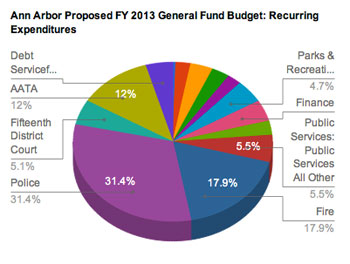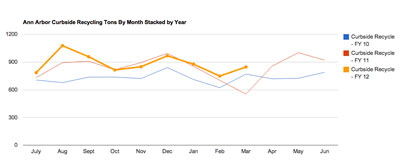Ann Arbor Council Gets Draft 2013 Budget
At the Ann Arbor city council’s April 16, 2012 meeting, city administrator Steve Powers presented the Ann Arbor city council with his proposed budget for fiscal year 2013, which begins on July 1, 2012. He described the current situation as one where the city has emerged from the crisis of the last few years and is ready to return its focus to “sustaining our future.”
The total expenditure budget for FY 2013 – across all funds, including utilities, solid waste and the like – is proposed at $404,900,312 in revenues against $382,172,603 in expenses.

About half of the recurring expenditures in the proposed FY 2013 budget for the city of Ann Arbor general fund are made up by safety services – police and fire. (Image links to Google spreadsheet.)
The proposed budget for the much smaller general fund – out of which the city pays for services like fire and police, planning, financial services, administration, parks and recreation – shows $79,193,112 in revenues against expenses totaling $78,869,750 for a planned surplus of $323,362. The following year, FY 2014, is currently projected to be basically a break-even year.
That’s similar to the picture that chief financial officer Tom Crawford had sketched out for the city council at a Feb. 13, 2012 work session. But he’d projected close to $1 million in net surplus – which included $1.6 million in surplus on the recurring revenue and recurring expenses side.
So the city administrator’s budget includes some additional one-time, non-recurring expenses as well as some additional costs, compared to Crawford’s February sketch. An example of a greater recurring cost is the settlement of the firefighters union contract. A more frequent mowing cycle in the parks – every 14 days instead of every 19 days – is an additional cost. An example of an additional non-recurring cost is an allocation for the local matching portion of the High Speed Intercity Rail project – the city’s current nomenclature for the Fuller Road Station, while the final site determination of such a station is still pending.
With some notable exceptions in police and fire, the proposed FY 2013 budget mostly reflects the planning done a year ago when the FY 2012 budget was adopted. (Although the city of Ann Arbor adopts annual budgets, it plans in two-year cycles.)
Highlights of the proposed FY 2013 budget that are different from the two-year plan include the addition of one police officer instead of eliminating nine positions (for an additional cost of $1,038,167). Staffing for the police department as a whole, however, will include a reduction of 19 dispatcher positions, because the city is now contracting with Washtenaw County for dispatch services. In the city administrator’s budget message to the council, the savings due to the outsourcing of dispatch operations are identified as $1,238,297. Also identified in the budget message are $477,000 in savings from labor contract settlements with the police unions.
The proposed budget also calls for maintaining the budgeted staffing for the fire department at 82 firefighters, instead of reducing firefighter positions by five positions (for an additional cost of $584,000). The recent contract settlement with the firefighters union is listed as a $229,000 additional cost – firefighters are being paid to work more hours. However, $657,000 in additional revenues to the fire department are also identified – due primarily to increased inspections and the fees associated with that. At the March 12 work session when fire chief Chuck Hubbard presented a new, three-station coverage model to the city council, he stated that he felt the ideal number of firefighters for the Ann Arbor department would be 88 firefighters.
In terms of utility rates, the drinking water, sanitary sewer, and stormwater fees are proposed to increase between 3.25% to 4.25%.
According to Ann Arbor’s city charter, the city administrator must present the city council with a proposed budget for the next fiscal year at its second meeting in April, which fell on April 16 this year. The city council then must make any amendments to the proposed budget by the second meeting in May. This year that falls on May 21. Public hearings on the budget and associated fee changes will be held at the council’s May 7 meeting.
Basic Revenues and Expenditures
On April 9, Ann Arbor city councilmembers were presented with a three-ring binder containing the “budget book.” The binder includes the budget message from the city administrator, and a more detailed breakdown of expenses and revenues. From the overview of the budget in the city administrator’s budget message, here’s the basic picture:
Proposed General Fund Expenditures
==================================
RECURRING ITEMS
$ 375,710 Mayor & Council
1,884,968 City Attorney
2,850,801 City Administration - Administrator, Clerk, Human Resources
2,282,293 Planning & Development
1,785,341 Community Development
3,637,332 Parks & Recreation
3,353,179 Finance
2,256,299 Public Services: Parks Forestry & Operations
4,302,228 Public Services: Public Services All Other
13,913,103 Fire
24,401,485 Police
3,992,372 Fifteenth District Court
9,317,684 AATA
3,467,954 Debt Service/Transfers/Other
-----------
$77,820,749 Subtotal Recurring Expenditures
NON-RECURRING EXPENDITURES
==========================
$ 272,220 Golf Operations Subsidy
100,000 Building Settlement Funding
154,000 Housing Commission Subsidy
65,000 Court Facilities Fund Transfer
150,000 Police Recruit Program
307,781 High Speed Intercity Rail Grant Match
-----------
$ 1,049,001 Subtotal Non-Recurring Expenditures
===========
$78,869,750 Total General Fund Expenditures
PROPOSED GENERAL FUND REVENUES
$49,431,784 Taxes
9,265,416 State-shared Revenue
5,722,493 Charges for Services
4,501,601 Fines & Forfeitures
10,271,818 Other
===========
$79,193,112 Total General Fund Revenues
$323,362 Excess of Revenues over Expenditures
-
That surplus is about $1 million less than the surplus that city of Ann Arbor chief financial officer Tom Crawford had projected and recommended at the council’s February work session. It’s worth pointing out that while the Ann Arbor Transportation Authority is included in the city’s general fund budget, the revenue from the city’s transit tax (roughly 2 mills) is essentially passed through to the AATA.
Across all of its funds, the city levies the following taxes. Amounts are in mills. (One mill is $1 for every $1,000 of taxable value of a piece of property.) The rates this year are the same as those for last year, except for the street reconstruction millage, which increased slightly for two reasons. First, it was approved by voters in November 2011, which reset it after being “Headlee-ized.” [The state's Headlee Amendment rolls back millage rates to prevent property tax revenues from increasing faster than the rate of inflation.] Voters also approved an addition 0.125 mill to fund sidewalk repair.
FY 2013 City of Ann Arbor Millage Rates ======================================= 6.1682 GENERAL OPERATING 2.0560 EMPLOYEE BENEFITS 2.4670 REFUSE COLLECTION 2.0560 AATA 2.1250 STREET RECONSTRUCTION 1.0969 PARK MAINTENANCE & CAPITAL IMPROVEMENTS 0.4779 OPEN SPACE & PARKLAND PRESERVATION 0.1250 DEBT SERVICE ------------- 16.5720 TOTAL
-
[.pdf scan of city administrator's budget message] [.pdf scan of revenues and proposed fees] [.pdf scan of expenditures]
Initial Review
Councilmembers will have until May 21 – their second meeting in May – to amend the administrator’s proposed budget. According to the city charter, a failure by the council to act by the second meeting in May results in the automatic adoption of the city-administrator-proposed budget. An initial look by The Chronicle through the budget yielded the following highlights.
Initial Review: Station Model For Fire Protection: Three Stations?
At a city council work session held on March 12, 2012, fire chief Chuck Hubbard presented a proposal for a three-station model for fire protection. Currently the city has five stations. Hubbard’s proposal included the closure of Station #3, Station #4 and Station #6. But Hubbard’s proposal also included re-activating the dormant Station #2, and distributing existing resources across three stations – #2, #1, and #5. Hubbard’s plan is driven by a desire to provide better coverage for the city, as measured by the “four-in-four” standard – the ability to put four firefighters on a fire scene within four minutes of departing the fire station. [For more detail, see Chronicle coverage: "A Closer Look at Ann Arbor's Fire Station Plan."]
In the proposed budget, however, the breakdown of funds by activity appear to show a continuation of the five-station fire protection model.
Actual Actual Budget Forecasted Request Activity FY2010 FY2011 FY2012 FY2012 FY2013 -------------------------------------------------------------------------- 3231 Fire Station #1 5,274,813 5,680,028 4,912,966 11,148,606 4,803,239 3233 Fire Station #3 818,528 753,316 703,736 1,433,592 3234 Fire Station #4 1,035,898 1,061,235 1,050,551 1,032,018 3236 Fire Station #6 1,176,140 1,175,390 1,179,073 1,229,143 3237 Fire Station #5 1,182,880 1,204,505 1,318,853 1,283,750
-
According to city administrator Steve Powers at a press briefing before the April 16 council meeting, that breakdown does not reflect an abandonment of the plan to adopt the three-station model. However, it does reflect that Hubbard’s presentation was a proposal that will need additional public input, Powers said. Powers indicated that he and Hubbard would be going out to the community to present the plan and get reaction and input sometime in the fall of 2012, before making a decision. It’s a decision that can be made administratively, and does not need a vote by the city council.
By the fall, implementation of the three-station model would not be impeded by the East Stadium bridges reconstruction over State Street and the railroad tracks. The bridges would be crucial to providing Station #2 fire trucks access to the areas currently covered by Station #3, for example. The reconstruction of the bridges is expected to be complete, with traffic lanes reopened for vehicles by November 2012.
Powers was clear about the fact that no decision had been made either way on a three-station model.
Initial Review: High Speed Intercity Rail Grant Match
The overview of the budget presented above includes an item under non-recurring expenditures for $307,781 labeled “High Speed Intercity Rail Grant Match.” This item is addressed specifically in the proposed budget resolution that’s included in the city administrator’s budget message:
Whereas, The High Speed Intercity Rail project (in funds 00CP and 00MG) anticipates receipt of up to $307,781 by June 30, 2012 but may conclude the fiscal year with a fund deficit if the funds are not received, and the City has included sufficient funding in the FY 2013 budget to remedy the deficit should it materialize;
RESOLVED, That if the High Speed Intercity Rail project ends fiscal year 2012 with a deficit, the City’s approved deficit elimination plan (under MCL 141.921) would be the transfer of up to $307,781 from the General Fund as provided for in the FY 2013 budget;
The High Speed Intercity Rail project is more familiar in the community as the Fuller Road Station project. The project has been awarded $2.8 million by the Federal Rail Administration – for site analysis and environmental assessment. So from the point of view of the FRA grant, it’s somewhat premature to conclude with finality that the preferred site will be the Fuller Road site.
The FRA grant would cover 80% of the initial $3.5 million environmental assessment project. That leaves the required local matching share (20%) at $0.7 million. Some of the work associated with the environmental assessment that has already been completed would be eligible to count as part of the local match. The University of Michigan’s participation in the project was envisioned to help cover the local matching requirement of federal grants associated with the project.
So the anticipated receipt of $307,781 would possibly come from UM. It’s not clear when or if that money would be contributed by UM in connection with the project. That’s because on Feb. 10, 2012, UM and the city announced that the university was withdrawing from the project. [See Chronicle coverage: "UM, Ann Arbor Halt Fuller Road Project"]
At the press briefing before the April 16 council meeting, Powers indicated that in the coming weeks, a conversation would be initiated by the city with UM to explore what already-incurred site study costs could be borne by UM – in the context of the memorandum of understanding that had guided the partnership until earlier this year. To put the initial $3.5 million environmental assessment in perspective, the rail station component of the project is estimated to cost about $18 million, with necessary modifications and upgrades to tracks totaling an additional $6-7 million.
If conversations with UM do not yield a contribution of $307,781 by June 30, 2012, then the budget resolution essentially says that the general fund will be tapped to make the major grants fund and the general capital funds whole.
The general fund is the most flexible of all the city’s funds, in that it can be used as a last resort to backstop other funds. However, mayor John Hieftje has stated on several occasions, as the project has been discussed over the last few years, that it was not the city’s intention to use general fund money to pay for the Fuller Road Station project.
Initial Review: RecycleBank
At its Sept. 19, 2011 meeting, city council voted to retain the contract it had signed the previous year with RecycleBank – to administer a coupon incentive program associated with curbside single-stream recycling program. There had been some interest on the council in canceling the contract entirely, but the council settled on a contract revision that was favorable to the city.
The new contract reduced the per-household charge by about one-third, from $0.52 to $0.35 – which translated into a monthly payment reduction from $12,400 to $8,371. Under the contract authorized by the council, if the tonnage of recyclables collected increases above current levels, RecycleBank could earn an additional $50 per ton, for each ton collected above existing levels. There would be a cap of $150,000 per year.
Part of the reluctance of the council to cancel the contract were the terms under which the city could withdraw from the agreement. The language of the contract appears to indicate that the city cannot cancel the contract, without certain penalties, as long as there is money allocated in the budget for the contract.
City administrator Steve Powers indicated at the press briefing that there is money allocated for the RecycleBank contract in the FY 2013 budget.
Here’s some charts based on recent trash and recycling numbers from the city of Ann Arbor. [Google spreadsheet] Since the council approved the new RecycleBank contract in September 2011, recycling numbers have essentially tracked close to the previous year – with the exception of the most recent month’s numbers, March 2012, which showed a substantial year-over-year increase.

Ann Arbor curbside recycling tonnages by month, stacked by year. Most recent year (FY 2012) is in yellow. (Image links to higher resolution file. )

Ann Arbor curbside recycling and trash by month. The red line is trash. The blue line is recycling. (Image links to higher resolution file.)
Next Steps
In past years, a “budget town hall” has been held around this time of year – a public meeting typically videotaped by Community Television Network – to introduce the budget to the public. In lieu of that kind of event, Powers indicated at the press briefing that he was currently planning to appear on the CTN Conversations program on May 7, where viewers have an opportunity to call in with questions.
This brief was filed from the city council’s chambers on the second floor of city hall located at 301 E. Huron. A more detailed report will follow.
The Chronicle could not survive without regular voluntary subscriptions to support our coverage of public bodies like the Ann Arbor city council. Click this link for details: Subscribe to The Chronicle. And if you’re already supporting us, please encourage your friends, neighbors and colleagues to help support The Chronicle, too!



